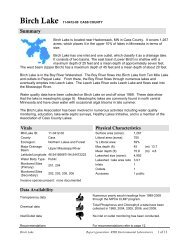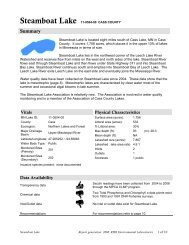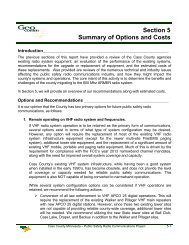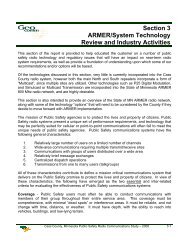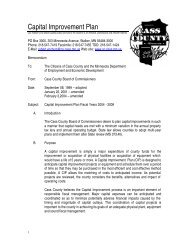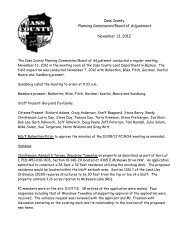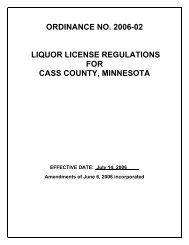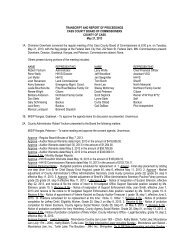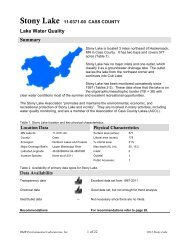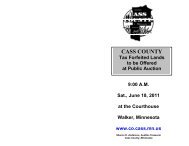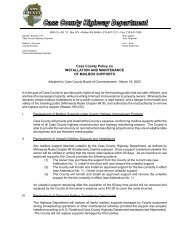Feedlot Ordinance - Cass County, Minnesota
Feedlot Ordinance - Cass County, Minnesota
Feedlot Ordinance - Cass County, Minnesota
You also want an ePaper? Increase the reach of your titles
YUMPU automatically turns print PDFs into web optimized ePapers that Google loves.
CASS COUNTYFEEDLOTMANAGEMENT ORDINANCEEFFECTIVE DATE: MAY 28, 2001 VERSION
TABLE OF CONTENTS100 STATUTORY AUTHORITY -----------------------------------------------------------------------------------4200 POLICY-------------------------------------------------------------------------------------------------------------4300 GENERAL PROVISIONS AND ENFORCEMENT------------------------------------------------------4310 JURISDICTION------------------------------------------------------------------------------------------------------------------------4320 PERMITS REQUIRED ---------------------------------------------------------------------------------------------------------------4330 COMPLIANCE ------------------------------------------------------------------------------------------------------------------------4340 ENFORCEMENT----------------------------------------------------------------------------------------------------------------------4350 PROSECUTION -----------------------------------------------------------------------------------------------------------------------5360 CEASE AND DESIST ORDERS----------------------------------------------------------------------------------------------------5370 DUTY TO ENFORCE ----------------------------------------------------------------------------------------------------------------5380 ADMINISTRATIVE FEES AND RESTORATION -----------------------------------------------------------------------------5390 PERFORMANCE BOND ------------------------------------------------------------------------------------------------------------5391 INTERPRETATION ------------------------------------------------------------------------------------------------------------------5395 SEVERABILITY-----------------------------------------------------------------------------------------------------------------------5398 ABROGATION AND GREATER RESTRICTIONS---------------------------------------------------------------------------6400 DEFINITIONS-----------------------------------------------------------------------------------------------------6500 FEEDLOT CONDITIONAL USE PERMIT REQUIREMENTS ---------------------------------------9510 STANDARDS FOR CONDITIONAL USE PERMITS-------------------------------------------------------------------------9520 CONDITIONAL USE PROCESSING ---------------------------------------------------------------------------------------------9600 VARIANCES ---------------------------------------------------------------------------------------------------- 10610 APPLICATION AND NOTICES ------------------------------------------------------------------------------------------------- 10620 VARIANCE CRITERIA------------------------------------------------------------------------------------------------------------ 10630 FINDINGS OF FACT --------------------------------------------------------------------------------------------------------------- 11640 CONDITIONS ------------------------------------------------------------------------------------------------------------------------ 11650 APPEAL OF DECISIONS --------------------------------------------------------------------------------------------------------- 11660 LAPSE OF VARIANCE ------------------------------------------------------------------------------------------------------------ 11
700 ANIMAL UNITS ------------------------------------------------------------------------------------------------ 11800 AREA REGULATIONS FOR FEEDLOTS -------------------------------------------------------------- 12810 MINIMUM AREA REQUIRED -------------------------------------------------------------------------------------------------- 12820 SETBACKS --------------------------------------------------------------------------------------------------------------------------- 12810.1 <strong>Feedlot</strong>s and Manure Storage Structures------------------------------------------------------------------------------------------ 12810.2 Animal Waste Application Setbacks ---------------------------------------------------------------------------------------------- 13900 ODOR MANAGEMENT PLAN ----------------------------------------------------------------------------- 131000 STANDARDS FOR MANURE STORAGE STRUCTURES--------------------------------------- 131100 STANDARDS FOR TRANSPORTATION OF MANURE: ----------------------------------------- 141200 AGRICULTURAL USE EASEMENTS------------------------------------------------------------------ 151300 ADOPTION ---------------------------------------------------------------------------------------------------- 151400 APPENDIX A--AG WASTE OPERATION AND MAINTENANCE PLAN---------------------- 161410 ALL COMPONENTS OF THE SYSTEM:------------------------------------------------------------------------------------ 161420 WASTE STORAGE STRUCTURES AND HOLDING PONDS: --------------------------------------------------------- 161430 OTHER PRACTICES AND APPURTENANCES: -------------------------------------------------------------------------- 161440 EMERGENCY CONTACT ------------------------------------------------------------------------------------------------------ 171450 APPLICANT’S AGREEMENT:------------------------------------------------------------------------------------------------- 171500 APPENDIX B--DEAD ANIMAL DISPOSAL PLAN-------------------------------------------------- 181600 APPENDIX C--ADDITIONAL MANURE DISPOSAL AREA AGREEMENT------------------ 191700 APPENDIX D AGRICULTURAL MANAGEMENT EASEMENT ------------------------------ 201800 APPENDIX E--CONSTRUCTION INSPECTION GUIDELINES--------------------------------- 223
100 STATUTORY AUTHORITYThis <strong>Cass</strong> <strong>County</strong> <strong>Feedlot</strong> <strong>Ordinance</strong>, herein referred to as “<strong>Ordinance</strong>”, is adopted pursuant to the authorization andpolicies contained in <strong>Minnesota</strong> Statutes, Chapters 115 and 116, the most recent version of <strong>Minnesota</strong> Rules, Chapter7020, and the planning and zoning enabling legislation in <strong>Minnesota</strong> Statutes, Chapter 394.200 POLICYLivestock and poultry are important to producers and consumers in <strong>Cass</strong> <strong>County</strong>. Animals provide meat, milk, eggs andrelated products for consumption in the United States and for export. Livestock production is an important source ofincome for farmers and agricultural businesses in the county. Efficient livestock production should be a concern ofproducers and consumers alike.It is recognized that in certain quantities, livestock, poultry, and other animals produce manure that may negatively affectthe <strong>County</strong>’s environment.The following standards for the control of livestock, poultry, and other animal facility(s) and manure application have beenpromulgated to provide protection against pollution caused by manure from domesticated animals. These standardsrecognize that animal manure provides beneficial qualities to the soil and plant production.All feedlot owners and operators shall act as good neighbors when applying animal manure. The time of year, winddirection, and neighboring dwellings shall be considered when selecting appropriate time and place of application.By following these regulations the environmental, residential, and agricultural uses of land will be more compatible. Thepurpose of the feedlot ordinance is to regulate feedlots and animal waste storage and use, and protect agricultural landuse in <strong>Cass</strong> <strong>County</strong> so that effects on the health, safety, and general welfare of the public will be minimized.300 GENERAL PROVISIONS AND ENFORCEMENT310 JURISDICTIONThe provisions of this <strong>Ordinance</strong> shall apply to all feedlots, as defined in this ordinance, in all unincorporated areas of <strong>Cass</strong><strong>County</strong>.320 PERMITS REQUIREDNo person shall operate a feedlot with an annual average stocking rate of 300 animal units or more without first obtaining a<strong>Cass</strong> <strong>County</strong> feedlot permit when any of the following conditions exist:A. A new feedlot is proposed where a feedlot did not previously exist;B. changes in the annual average stocking rate which exceed 300 animal units;C. An existing feedlot is restocked with 300 or more animal units after being abandoned or unused for 5 or moreyears.No permits will be issued to landowners or on property on which there are current or past unresolved violationsexisting.330 COMPLIANCEThe landowner, and the permitee, and the operator of any feedlot shall be responsible for the establishment, expansion,and management of that animal feedlot, and the transportation, storage, and disposal of animal manure generated in amanner consistent with the certificate of compliance and the standards set forth in this <strong>Ordinance</strong>, all other <strong>County</strong><strong>Ordinance</strong>s, and the <strong>Minnesota</strong> Pollution Control Agency unless otherwise approved.340 ENFORCEMENTThe <strong>County</strong> Board and the Department, are responsible for the administration and enforcement of thisordinance. Any violation of the provisions of this ordinance or failure to comply with any of its requirements bya landowner or their agent, including violations of or failure to comply with conditions and safeguards4
established in connection with the granting of, or contained with, variances or conditional uses shall constitutea misdemeanor and shall be punishable as defined by <strong>Minnesota</strong> State Statutes. Violations of this <strong>Ordinance</strong>can occur regardless of whether or not a conditional use permit is required for a regulated activity. Each dayof a violation of this ordinance or each day that a failure to comply with any requirements of this ordinancecontinues shall constitute a separate offense. The Department and the Sheriff shall have the power to enforcethis ordinance by issuing citations for criminal violations of this ordinance upon the owner of a property and/ortheir agent. The <strong>County</strong>, through the Department may sue for injunctive relief on any violation, includingrestoration of the premises to its condition existing prior to the violation.350 PROSECUTIONThe Department may enforce the provisions of the ordinance whether through criminal prosecution, civilremedy, or both. Utilization of a civil remedy shall not prevent a criminal prosecution for the same violation. Acriminal prosecution for a violation shall not be a bar to a civil remedy.360 CEASE AND DESIST ORDERSCease and desist orders may be issued when the Department has probable cause that an activity regulated by this or anyother <strong>County</strong> ordinance is being or has been conducted without a permit or in violation of a permit. When work has beenstopped by a cease and desist order, it shall not again be resumed until the reason for the work stoppage has beencompletely satisfied and the cease and desist order lifted.370 DUTY TO ENFORCEIt shall be the duty of the <strong>County</strong> Attorney and <strong>County</strong> Sheriff to perform such duties as may be necessary toenforce the provisions of this ordinance.380 ADMINISTRATIVE FEES AND RESTORATIONAny application for a permit which is made after the work is commenced and which requires a permit shall becharged an additional administrative fee. In addition, the Planning Commission, Board of Adjustment, or theDepartment may require correction and/or restoration of the property concerned to its original state should theapplication for a permit be denied or if the action permitted does not include all or part of the work commencedprior to approval of said permit.390 PERFORMANCE BONDUpon approval of a conditional use or variance, the Planning Commission, Board of Adjustment, or theDepartment may require a surety bond, cash escrow, or letter of credit prior to the issuing of a feedlot permit.Said security shall be irrevocable and shall guarantee conformance and compliance with the conditions of theconditional use, or variance, and the <strong>Ordinance</strong>.391 INTERPRETATIONIn their interpretation and application, the provisions of this ordinance shall be held to be minimumrequirements and shall be liberally construed in favor of the <strong>County</strong> and shall not be deemed a limitation orrepeal of any other powers granted by <strong>Minnesota</strong> Statutes.395 SEVERABILITYIf any section, clause, provision, or portion of this ordinance is adjudged unconstitutional or invalid by a courtof law, the remainder of this ordinance shall not be affected.5
398 ABROGATION AND GREATER RESTRICTIONSIt is not intended by this ordinance to repeal, abrogate, or impair any existing easements, covenants, or deedrestrictions. However, where this ordinance imposes greater restrictions, the provisions of this ordinance shallprevail. All other ordinances inconsistent with this ordinance are hereby repealed to the extent of theinconsistency only.400 DEFINITIONSAbandoned - A dwelling, building, barn, feedlot, or other facility left unused for five (5) years or more.Agency- <strong>Minnesota</strong> Pollution Control Agency.Agricultural Use Easement- A restriction recorded on the deed of certain residential property(ies) adjacent to a feedlotwhich limits the right of the residential owner to object to certain livestock and animal waste management practices.Animal Unit - means a unit of measure used to compare differences in the production of animal manures that employs asa standard the amount of manure produced on a regular basis by a 1,000 pound slaughter steer or heifer.Animal Waste - Poultry, livestock, or other animal manure or a mixture of manure with feed, bedding, or other materials.Board of Adjustment - The <strong>Cass</strong> <strong>County</strong> Board of Adjustment as described in <strong>Minnesota</strong> Statutes, Section 394.27.Church. A building, together with its accessory buildings and uses, where persons regularly assemble for religiousworship and which building, together with its accessory buildings and uses, is maintained and controlled by a religiousbody organized to sustain public worship.Conditional Use - means a land use or development as defined by ordinance that would not be appropriategenerally but may be allowed with appropriate restrictions as provided by official controls upon a finding that(1) certain conditions as detailed in the zoning ordinance exist, (2) the use or development conforms to thecomprehensive plan of the county, and (3) the use is compatible with the existing neighborhood..<strong>County</strong> - <strong>Cass</strong> <strong>County</strong>.<strong>County</strong> Board - <strong>Cass</strong> <strong>County</strong> Board of Commissioners.Department - <strong>Cass</strong> Environmental Services Department.Dwelling - Consists of one or more rooms which are arranged, designed or used as living quarters for one family orhousehold. For the purpose of this ordinance, a dwelling unit may be a manufactured or mobile home.Farm - A tract of land, which is principally used for agricultural activities such as the production of crops or animals. Afarm may include agricultural dwellings and accessory buildings and structures necessary to the operation of the farm andmust meet the definition of “farm” under <strong>Minnesota</strong>’s Green Acres Law M.S.A., Chapter 273.111.Farmstead - A development area designed and arranged to support farm activities. A variety of structures, storage area,and other facilities, including adjacent windbreaks and shelterbelts, typically comprise a farmstead. The area may containone or more Farm Dwellings. A feedlot may be present within the defined area of a Farmstead, but for the purpose of this<strong>Ordinance</strong>, <strong>Feedlot</strong>s shall not be considered to be part of a Farmstead. A Farmstead has boundaries which can beapproximately defined and differentiated from surrounding fields and pastures, and the Department shall determine suchboundaries as necessary.<strong>Feedlot</strong> - A lot or building or combination of lots and buildings intended for the confined feeding, breeding, raising, orholding of animals and specifically designed as a confinement area in which manure may accumulate, or where theconcentration of animals is such that a vegetative cover cannot be maintained within the enclosure. Pastures shall not beconsidered feedlots under these parts.<strong>Feedlot</strong>, Existing - Any feedlot at the time of enactment of this ordinance.6
<strong>Feedlot</strong>, New - A feedlot constructed and operated on a site where no feedlot existed previously, or where a pre-existingfeedlot has been abandoned or unused for a period of five (5) years or more.Hardship - As used in connection with the granting of a variance means the property in question cannot be put to areasonable use if used under the conditions allowed by the official controls; the plight of the landowner is due tocircumstances unique to the property not created by the landowner; and the variance, if granted, will not alter the essentialcharacter of the locality. Economic considerations alone shall not constitute a hardship if a reasonable use for the propertyexists under the terms of the <strong>Ordinance</strong>. No variance may be granted that would allow any use that is prohibited in thezoning district in which the subject property is located.Incorporated - When manure is surface mechanically applied and tilled into the soil within 48 hours of application.Injected - When manure is mechanically injected or tilled into the soil during the manure application.Liquid Manure - Manure which is four percent solids or less.Manure storage structure - Diked or excavated structure lined with a concrete or synthetic liner, or a concrete tank inwhich manure is stored.MPCA - <strong>Minnesota</strong> Pollution Control Agency.NRCS - Natural Resources Conservation Service.Non-Farm Dwelling - Any dwellings located on a parcel of land contiguous to or surrounded by farm land which is underseparate ownership and whose occupants do not derive their predominant income from agricultural activities on the farm.Non-Ruminant - Monogastric animals, including swine, chickens, turkeys, and ducks that have a simple digestive tractthat is unable to digest forages.Odor Management Plan -Plan detailing any system or practice designed to reduce the migration of hydrogen sulfide andother gasses released by animal manure from a manure holding facility or manure application site.Ordinary High Water Level (OHWL) - The boundary of public waters and public waters wetlands shall be an elevationestablished by the Department of Natural Resources-Division of Waters, or delineating the highest water level which hasbeen maintained for a sufficient period of time to leave evidence upon the landscape, commonly that point where thenatural vegetation changes from predominantly aquatic to predominantly terrestrial. For watercourses, the ordinary highwater level is the elevation of the top of the bank of the channel. For reservoirs and flowage, the OHWL is the operatingelevation of the normal summer pool.Owner - Any individual, firm, association, syndicate, partnership, corporation, trust or other legal entity having sufficientproperty interest in a property to commence and maintain proceedings under this <strong>Ordinance</strong>, or the owner of record.Pastures - Areas where grass or other growing plants are used for grazing and where the concentration of animals is suchthat a vegetation cover is maintained during the growing season except in the immediate vicinity of temporarysupplemental feeding, temporary holding facilities, or watering devices.Permitee - Any owner or person who as been granted a permit.Person - Any individual, firm, partnership, corporation, company, association, joint stock association or body politic;including any trustee, receiver, assignee, or other similar representative thereof.Planning Commission - the <strong>Cass</strong> <strong>County</strong> Planning Advisory Commission as described in <strong>Minnesota</strong> Statutes,Section 394.30..Protected Waters- Any waters as defined in <strong>Minnesota</strong> Statutes, Section 103G.005, Subdivision 14 and 15. A body ofwater, river, or stream capable of substantial beneficial public use. This shall be construed to mean, for the purposes ofthis <strong>Ordinance</strong>, any body of water that has the potential to support any type of recreational pursuit or water supply purpose.The term “protected water” is synonymous with the term “public water” for the purpose of this <strong>Ordinance</strong>.7
Protected Waters Wetlands - All types 3, 4, and 5 wetlands, as defined in United States Fish and Wildlife ServiceCircular No. 39 (1971 edition), not included within the definition of public waters, that are ten or more acres in size inunincorporated areas or 2-1/2 or more acres in incorporated areas.Pseudo-Ruminant - Animals, including horses, rabbits, guinea pigs, and hamsters that have an enlarged cecum, whichallows microbial digestion of forages.Public Park - A <strong>County</strong>, State or Federally dedicated public area of land, with or without buildings, intended for outdooractive or passive recreational uses.Road - A public right-of-way affording primary access by pedestrians and vehicles to abutting properties, whetherdesigned as a street highway, parkway, road, avenue, boulevard, lane, service road, place or however otherwise designed.Acceptance of a road for maintenance purposes by a unit of government is not necessary for designation as a road.Road, Private - An unplatted access to more than one lot or parcel, including leased or rental properties where publicaccess is limited.Rule(s) – The most current version of the <strong>Minnesota</strong> Pollution Control Agency <strong>Feedlot</strong> Rules pursuant to <strong>Minnesota</strong> Rules,Chapter 7020.Ruminant - Polygastric animals, including cattle, sheep, and goats that have a rumen, which allows microbial digestion offorages.Setback - The minimum horizontal distance between a structure, sewage treatment system, feedlot, manure storagestructure, or other facility or feature, and an OHWL, top of a bluff, road, highway, property line, or other facility or feature.Shoreland - Land located within the following distances from protected waters: 1,320 feet from the ordinary high waterlevel of a lake, river, pond or flowage, the Mississippi River corridor as designated in the Mississippi HeadwatersManagement Plan, and the landward extent of a floodplain designated by ordinance on a river or stream whichever isgreater.Urban Growth Areas – Areas adjacent to a municipality, designated through official public policy, within which futurecommercial and residential growth is planned.Use - The purpose for which land or premises or a building thereon is designated, arranged or intended, or for which it isor may be occupied or maintained.Use, Agricultural - Means that use of land for the production of food or fiber, their storage on the farm, and/or the raisingthereon of animals.Variance - Any modification or variation of this <strong>Ordinance</strong> where it is determined that, by reason of exceptionalcircumstances, the strict enforcement of this <strong>Ordinance</strong> would cause unnecessary hardship.Waste Utilization Plan - A plan developed in accordance with the standards and specifications of the Natural ResourcesConservation Service which designates specific land areas for the spreading of animal waste and the rates at which thatanimal waste can be applied on an annual basis.Waterway - A natural or constructed channel that is shaped or graded and is established in sustainable vegetation for thestable conveyance of run-off.Waiver - The intentional or voluntary written relinquishment of a landowner’s right under this ordinance.Wetland(s) - lands transitional between terrestrial and aquatic systems where the water table is usually at ornear the surface, or the land is covered by shallow water. For the purpose of this definition, wetlands musthave the following three attributes:(1) have a predominance of hydric soils;(2) are inundated or saturated by surface or ground water at a frequency and duration sufficient to support aprevalence of hydrophytic vegetation typically adapted for life in saturated soil conditions and;(3) under normal circumstances support a prevalence of such vegetation.8
C. The Planning Commission shall consider the application at its next regular meeting, after compliance withnotice requirements of this section.D. The Planning Commission shall consider each conditional use applied for under this section. If the permit isdenied, the Planning Advisory Commission shall advise the applicant of the reasons therefore in writing withintwenty (20) days of the date of decision.E. Any resubmission of a conditional use application, if previously denied, shall be allowed only if the plans havebeen substantially amended.F. The decision of the Planning Advisory Commission shall not be final. Any person having an interest affected bythe decision, has the right to appeal to District Court on questions of law and fact within thirty (30) days fromthe date of recording the conditional use permit on the applicant’s deed. No work may proceed orother permits issued until this appeal period has expired..G.The Department shall record approved conditional uses on the deed of the affected property in the office of the<strong>County</strong> Recorder. The conditional use shall include the legal description of the property involved along with anyconditions that may have been attached to the approval.600 VARIANCES610 APPLICATION AND NOTICESThe Board of Adjustment may grant a variance upon application and only in accordance with <strong>Minnesota</strong> Statutes, Chapter394. Any person may make an application to the Board of Adjustment for a variance from the literal provisions of thisordinance in instances where their strict enforcement would cause undue hardship because of circumstances unique tothe individual property under consideration and where the hardship is not solely economic. No variance application will beaccepted from landowners or on property on which there are existing violations or delinquent property taxes.Notice of time, place and purpose of any public hearings shall be published in the official newspaper of the county at leastten (10) days before the hearing. Written notice of public hearings regarding the application for variances, shall be sent toall property owners of record within five hundred (500) feet of the affected property or to the ten (10) nearest properties,whichever, would provide notice to the greatest number of owners. Written notice shall also be given to the affected TownBoard of Supervisors, and the municipal council within two (2) miles of the affected property.620 VARIANCE CRITERIAA variance may not circumvent the general purposes and intent of this ordinance. In no case shall a variance be grantedwhich the board determines will:A. Allow any use that is prohibited in the zoning district in which the subject property is located, or;B. Restrict the passage of storm water in such a manner as to increase the height of flooding or impact adjacentproperties, or;C. Result in incompatible land uses that would be detrimental to the protection of ground and surface waterquality, or;D. Not be in keeping with the land use and water plans and/or planning objectives of the <strong>County</strong> or which willincrease or cause danger to life or property, or;E. Be inconsistent with the preservation of natural land forms, vegetation or wetlands of the <strong>County</strong>, or;F. Result from the circumstances created by the landowner, or;G. Not be changed from a previously denied application.10
630 FINDINGS OF FACTIn ruling on a variance request, the Board of Adjustment must make written findings of fact upon the followingconsiderations and <strong>Minnesota</strong> Statutes, Chapter 394.27, Subd. 7:A. The property in question cannot be put to a reasonable use if used under the conditions allowed by the officialcontrols.B. The plight of the landowner is due to circumstances unique to the property not created by the landowner.C. The variance, if granted, will not alter the essential character of the locality.D. The need for the variance is not justified by economic considerations alone.640 CONDITIONSConditions, as deemed appropriate by the Board of Adjustment, may be attached to enforce the general purpose andintent of this <strong>Ordinance</strong>.650 APPEAL OF DECISIONSThe decision of the <strong>Cass</strong> <strong>County</strong> Board of Adjustment shall not be final. Any person having an interest affected by this<strong>Ordinance</strong> or any decision made relating to it shall have the right to appeal to District Court on question of law and factwithin thirty (30) days from the date of recording with the <strong>County</strong> Recorder. No work may proceed or otherpermits issued until this appeal period has expired.660 LAPSE OF VARIANCEA variance must be used within one year of the date the variance appeal period expires.700 ANIMAL UNITSFor the purposes of this ordinance, animal units for various types of animals will be calculated according thefollowing table:Animal UnitNo. of Head Needed to Equal:(A.U.)300 A.U.1 mature dairy cow 1.4 2141 slaughter steer or heifer 1.0 3001 horse 1.0 3001 swine over 55# 0.4 7501 sheep 0.1 3,0001 swine under 55# 0.05 6,0001 turkey 0.018 16,6671 chicken 0.01 30,000Other animals - average weight of animal / 1,000 # = A.U.11
800 AREA REGULATIONS FOR FEEDLOTS810 MINIMUM AREA REQUIREDThe minimum parcel size required to construct a new feedlot under the jurisdiction of this ordinance shall be 160 acres.820 SETBACKSSetbacks cited in this <strong>Ordinance</strong> shall be minimum standards and shall apply within all unincorporated areas within the<strong>County</strong>.810.1 <strong>Feedlot</strong>s and Manure Storage StructuresA. Setbacks for feedlots under the jurisdiction of this ordinance shall be measured from the outermostfoundations of buildings and/or the outermost extent of fences or yards that are parts of the facility. Setbacksfor manure storage structures under the jurisdiction of this ordinance shall be measured from the outermostfoundation of a concrete tank, or the outermost edge of the dike for a lined earthen basin.FEEDLOT SETBACKSFEATURE OR STRUCTURESETBACKPrivate Wells*200 feetPublic Waters1320 feetPublic Park or Church2640 feet<strong>County</strong>, Judicial or Private Ditch **400 feetPublic Road Right-of-way100 feetProperty Line100 feetRural Residences1320 feetIncorporated Municipalities1 milesPlanned Growth Areas1 miles*---Private well setback to a manure storage area shall be 400 feet**---reduce setback by 50% if separated by a 3 foot high earthen bermB. New feedlots shall not be located within the shoreland zone.C. No new feedlot shall be erected where ten (10) or more existing residences are situated within a radius of one(1) mile drawn from the outermost points of the proposed feedlots.D. No new non-farm dwelling shall be constructed within one-fourth (1/4) mile of an existing feedlot unless it is toreplace an existing dwelling, or has an ag-use easement deed recorded on the parcel on which the dwelling islocated.12
810.2 Animal Waste Application SetbacksA. Setbacks for animal waste application shall be measured from the outermost boundaries of fields on which thewaste is spread or injected as identified in the waste utilization plan. Application of all animal waste within<strong>Cass</strong> <strong>County</strong>’s unincorporated areas shall comply with the following setbacks:INCORPORATED ORSURFACE ORINJECTEDFEATURE OR STRUCTURE IRRIGATION APPLIED WITHIN 48 HOURSRivers, lakes wetlands, drainage ditches* 300 feet OHWL 100 feet OHWLMunicipal well 1,000 feet 1,000 feetPrivate wells 200 feet 100 feetResidence, neighboring resident 300 feet 100 feetPublic roadways 30 feet 10 feet*--Where an area’s topography slopes away from an adjacent watercourse, animal manure may be reduced or exemptedfrom the required setbacks upon written approval of the Department.B. All waste utilization of animal manure shall be according to the Natural Resources Conservation ServiceStandards as provided in Waste Utilization Plan #633.C. Where adequate acres for spreading animal waste are not available, spreading agreements with thelandowner’s signature (s) shall be provided to the MPCA and the Department by the feedlot operator. Thefeedlot operators shall follow up to date waste utilization plans and have additional manure application areaagreements for all areas upon which manure is spread. If the area available for spreading is reduced,corresponding animal units must be reduced, or alternative suitable areas found and manure application areaagreements secured in order to comply with the operator’s waste utilization plan.900 ODOR MANAGEMENT PLANA. <strong>Feedlot</strong> owners and operators shall be required to submit an Odor Management Plan for all new feedlots orexpansion of existing feedlots to the Department for review and approval. The plan shall:1. include best management practices(BMP’s) for peak odor periods such as spreading and agitation of storedmanure2. provide for methods of managing odors that will significantly reduce odor leaving the feedlot;3. include provisions for managing odors emanating from any new liquid manure storage structure.B. Enforcement of this section shall not commence until such time as the University of <strong>Minnesota</strong>-ExtensionService’s <strong>Feedlot</strong> and Manure Management Advisory Committee--Livestock Odor Taskforce recommendationsor a similar program have been enacted by state statute or rule.1000 STANDARDS FOR MANURE STORAGE STRUCTURESA. All plans shall be prepared and approved by NRCS or a registered professional engineer.B. All new or expanded manure storage structures shall be designed to store a minimum of 8 months manureproduction. Manure shall not be stored for longer than 1 year.C. All basins designed within the county shall meet minimum practice standards and recommendations of NRCSPractice Standards #425 for Waste Storage Ponds; and have an approved Waste Utilization Plan provided tothe Department including:13
1. A signed Operations and Maintenance Plan,2. A construction inspection plan agreement by the Engineer, and,3. A construction inspection log.D. Any situation not covered by the above standards shall be controlled by the Midwest Plan Service #18Livestock Waste Facilities Handbook, and applicable Agricultural Extension Engineering Fact Sheets involvinganimal waste.E. A synthetic or concrete liner shall be required.F. Owner and Operator’s Responsibility. The landowner, the owner, and the operator of a feedlot shall beresponsible for the storage, transportation, and disposal of all animal manure generated in a manner consistentwith the provisions of this <strong>Ordinance</strong>.G. All new construction of synthetic-lined or concrete storage facilities shall have a perimeter tile with inspectionsite, installed in accordance with MPCA guidelines. The permitee shall be responsible for hiring a Federal orState-certified testing laboratory, to sample the drain tile discharge from the inspection pipe for potential groundwater pollution for as long as the feedlot is in operation. These tests shall be conducted in the followingmanner:1. If flow is present in the tile, one sampling and analysis shall be done prior to operation of the feedlot toestablish a base water sample.2. After the first year of operation, testing shall then be conducted in each subsequent year in the month ofJune. If the tile is dry, it shall be checked again in October.3. If the tile is still dry in October, no test is required, and it shall be checked again the following June.4. Samples will be tested for nitrates and coliform bacteria.5. A copy of all test results shall be promptly submitted to the Department. Any noted increase incontaminants will be reviewed, a plan for corrective action developed by the Permitee, and approved by theDepartment.H. The permitee shall allow the Department to inspect the site whenever the Department deems necessary. TheDepartment shall provide a 96 hour written notice via registered mail-returned receipt in advance of anyinspection, except in the case of an on-going violation.I. Covers may be required by the Planning Commission, based on recommendations from technical agencies.J. All new and existing uncovered manure storage structures and basins shall be surrounded by metal, chain link,or wooden fencing to a minimum height of 6 feet, with fencing of sufficient construction to exclude children andlivestock. This fence shall be maintained whether or not the manure storage structure or basin is in use anduntil and unless the structure or basin is filled in with clean granular fill and abandoned.K. When use of any new or existing feedlot is discontinued, any associated manure storage structures must becompletely emptied and the manure spread in accordance with an approved waste utilization plan within 2months of the date use of the feedlot ceases.1100 STANDARDS FOR TRANSPORTATION OF MANURE:A. All vehicles used to transport animal manure on township, county, state, interstate highways, or throughmunicipalities shall be leakproof. This provision shall not apply to animal manure being hauled to fieldsadjacent to feedlot operations or fields divided by roadways, provided the animal manure is used as fertilizer.B. Any person located outside the jurisdiction of this <strong>Ordinance</strong> that transports manure to areas within thejurisdiction of this <strong>Ordinance</strong> with the intent of storing or disposing of said manure within <strong>Cass</strong> <strong>County</strong> shallprovide the Department with a complete manure management plan and shall comply with all provisions of thisordinance.14
1200 AGRICULTURAL USE EASEMENTSAs a part of any permit for a new residential development within one quarter mile of a feedlot and/or spreading areasidentified in the waste management plan, the owners of the property on which the residential development is located shallgrant to the owners of all property adjacent to the development, a perpetual nonexclusive easement as follows:A. The Grantors, their heirs, successors, and assigns acknowledge by the granting of this easement that theresidential development is situated in an agricultural area and may be subjected to conditions resulting fromcommercial agricultural operations on adjacent lands. Such operations include livestock raising and thestorage and application of animal manure, and other accepted and customary agricultural activities conductedin accordance with federal and state laws. These activities ordinarily and necessarily produce noise, dust,smoke, odors, and other conditions that may conflict with Grantors’ use of Grantors’ property of residentialpurposes. Grantors hereby waive all common law rights to object to normal and necessary agriculturalmanagement activities legally conducted on adjacent lands which may conflict with Grantors’ use of Grantors’property for residential purposes and grantors hereby grant an easement to adjacent property owners for suchactivities.B. Nothing in this easement shall grant a right to adjacent property owners for ingress or egress upon or acrossthe described property. Nothing in this easement shall prohibit or otherwise restrict the Grantors from enforcingor seeking enforcement of statutes or regulations of governmental agencies for activities conducted onadjacent properties.C. This easement is appurtenant to all property adjacent to the residential development and shall bind to the heirs,successors, and assigns of Grantors and shall endure for the benefit of the adjoining landowners, their heirs,successors, and assigns. The adjacent landowners, their heirs, successors, and assigns are hereby expresslygranted the right of third party enforcement of the easement.D. This easement shall be filed on forms provided by the Department (See Appendix D)1300 ADOPTIONBE IT ORDAINED THAT:THE CASS COUNTY FEEDLOT ORDINANCE IS HEREBY ADOPTED BY THE CASS COUNTY BOARD OFCOMMISSIONERS ON THIS_______________Day of __________________, 200_._____________________________________________Chairman, <strong>County</strong> Board of CommissionersATTEST:____________________________________EFFECTIVE DATE: _________________, 200_15
1400 APPENDIX A--AG WASTE OPERATION AND MAINTENANCE PLANThe permitee shall be responsible for maintaining conservation practices to assure that they continue to serve the purposefor which they were intended. The practices must be inspected periodically to enable proper operation and maintenance.The following requirements shall apply:1410 ALL COMPONENTS OF THE SYSTEM:A. Inspect embankments, water course channels and ridges, level spreaders and filter strips, and holding pondinlets regularly, especially following heavy rains and spring runoff. Repair damage as soon as conditions allowwith compacted earth fill, reshaping, staked sod, reseeding, and/or mulch as needed.B. Control brush, weed, and tree growth. Use herbicides that do no harm to the grass sod, or mow and clip wherepossible.C. Control gophers, moles, badgers, and woodchucks. They may burrow in the embankment, diversion dikes andlevel spreaders, creating holes that will cause wash-outs.D. Uncontrolled grazing shall not be permitted on the embankment sideslopes, grassed waterways, vegetateddiversions, and the filter strips.1420 WASTE STORAGE STRUCTURES AND HOLDING PONDS:NEVER ENTER CONFINED SPACES SUCH AS RECEPTION AND STORAGE PITS AND TANKS,PUMPING SUMPS, ETC., WITHOUT FIRST TESTING FOR POISONOUS GASES, ESTABLISHING ANDMAINTAINING POSITIVE VENTILATION TO THE SPACE AT ALL TIMES, AND USING SPOTTERS ANDPERSONAL SAFETY LINES FOR EACH PERSON ENTERING THE CONFINED AREA.A. Empty holding ponds and storage structures according to the waste utilization plan schedule.B. Agitate holding ponds only at the designated locations. Never agitate lined holding ponds except at the pointsspecifically designed for agitation.C. On runoff storage ponds, maintain the water level below the marker indicating sufficient storage remains tocontain the runoff from a single design storm vent.D. Maintain the holding pond embankment at the original height, width, and cross section as shown on theconstruction plan.E. Maintain a thick vegetative cover of grass on the embankment top and the exterior sideslopes and interiorsideslopes above the water storage “full” (pump-out marker) elevation.F. Keep holding pond inlets free from debris and sediments.1430 OTHER PRACTICES AND APPURTENANCES:A. Maintain all fences in good condition, repairing broken wires, gates, and posts to insure that the safety of thefencing is not compromised.B. Maintain all mechanical diversions (concrete and/or treated plank) as originally installed.C. Maintain commercially manufactured manure delivery systems (ram pumps, liquid pumps, gutter scrapers,etc.) in good operating condition according to manufacturer’s specifications and recommendations.D. Provide personal flotation device and/or life saving pole in the immediate vicinity.16
1440 EMERGENCY CONTACTIMMEDIATE CONTACT MUST BE MADE WITH THE COUNTY FEEDLOT OFFICER,CONSULTING ENGINEER, OR THE MINNESOTA POLLUTION CONTROL IF THERE IS:A. Evidence of holding pond leakage, such as:1. Seepage along the toe of the embankments (standing water, particularly “polluted” water; soft, spongy, wetareas; growth of water loving vegetation).2. Failure of the holding pond to fill up (water level remains constant over extended time periods or raises aftersignificant rains and then drops).3. A sudden drop in the water level.B. Evidence of significant waterway or diversion channel erosion.1450 APPLICANT’S AGREEMENT:I hereby certify that I understand, and will comply with, all provisions established in the Waste Utilization and Operation andMaintenance Plan as prescribed.Signature of ApplicantDate17
1500 APPENDIX B--DEAD ANIMAL DISPOSAL PLANI, will dispose of my livestock or poultry carcasses by one of the following: (Circlethe appropriate letter).A. Bury. The site must have a minimum of 3 ft. of cover, and 5 ft. of unsaturated soil above the seasonal highwater table.B. Incinerate. A 600 lb. load MPCA approved incinerator must be utilized. (Attach a copy of systemspecifications.)C. Render. Please provide the name and location of the rendering service to be utilized:D. Compost. This method must be constructed and operated as specified by the USDA CooperativeExtension Service.Please attach a copy of plans for the containment of dead animals during temporary storage and screening arrangements forthis structure. These plans must be deemed acceptable by the <strong>County</strong> Planning Commission.Signature of Livestock ProducerDate18
1600 APPENDIX C--ADDITIONAL MANURE DISPOSAL AREA AGREEMENTThe undersigned landowner agrees to allow manure from‘s livestockfacility to be spread on acres of his/her land in compliance with his/her Waste UtilizationPlan. This land is located in the one-quarter, of Section , inTownship, of<strong>County</strong>.Signature of Landowner or Tenant_________________________________DateAddress and Phone Number:19
1700 APPENDIX D AGRICULTURAL MANAGEMENT EASEMENTPARCEL ID #_______________________COUNTY________________GRANTOR(S) NAME______________________________________________________________________________________GRANTOR(S) ADDRESS________________________________________LEGAL DESCRIPTION:In accordance with section XV of the <strong>Feedlot</strong> <strong>Ordinance</strong>, <strong>Cass</strong> <strong>County</strong>, <strong>Minnesota</strong>, approving a permit for residentialdevelopment on the above described property, and in consideration of such approval, Grantors grant to the owners of allproperty adjacent to the above described property, a perpetual nonexclusive easement as follows:A. The Grantors, their heirs, successors, and assigns acknowledge by the granting of this easement that theresidential development is situated in an agricultural area and may be subjected to conditions resulting fromcommercial agricultural operations on adjacent lands. Such operations include livestock raising and thestorage and application of animal manure, and other accepted and customary agricultural activities conductedin accordance with federal and state laws. These activities ordinarily and necessarily produce noise, dust,smoke, odors, and other conditions that may conflict with Grantors’ use of Grantors’ property of residentialpurposes. Grantors hereby waive all common law rights to object to normal and necessary agriculturalmanagement activities legally conducted on adjacent lands which may conflict with Grantors’ use of Grantors’property for residential purposes and grantors hereby grant an easement to adjacent property owners for suchactivities.B. Nothing in this easement shall grant a right to adjacent property owners for ingress or egress upon or acrossthe described property. Nothing in this easement shall prohibit or otherwise restrict the Grantors from enforcingor seeking enforcement of statutes or regulations of governmental agencies for activities conducted onadjacent properties.C. This easement is appurtenant to all property adjacent to the above described property and shall bind to theheirs, successors, and assigns of Grantors and shall endure for the benefit of the adjoining landowners, theirheirs, successors, and assigns. The adjacent landowners, their heirs, successors, and assigns are herebyexpressly granted the right of third party enforcement of the easement.IN WITNESS WHEREOF, the Grantors have executed this easement dated this day of , 19.GrantorGrantor20
STATE OF MINNESOTA }} ss.COUNTY OF __________________}The foregoing instrument was acknowledged before me this________ day of __________,19___, by _________________________________________________________________________________________________________________________________________________, Owner(s)Notorial Stamp or Seal_____________________________________________Signature of Person Taking AcknowledgmentSTATE OF MINNESOTA }} ss.COUNTY OF __________________}The foregoing instrument was acknowledged before me this________ day of __________,19___, by _________________________________________________________________________________________________________________________________________________, Owner(s)Notorial Stamp or Seal_____________________________________________Signature of Person Taking Acknowledgment21
1800 APPENDIX E--CONSTRUCTION INSPECTION GUIDELINESThe Construction Inspection Plan shall contain the following minimum criteria:1. MPCA requires a registered professional engineer to design concrete storage structures having a capacity of500,000 gallons or greater.2. Contractor and landowner shall contact engineer prior to the start of construction to review plans andspecification requirements.3. During construction, the engineer will inspect the following:a. Moisture content of earth fill material.b. Compaction of earth embankment.c. Basin bottom and slope material after it is cut and placed to grade, but before it is scarified andrecompacted.d. Final elevations, grades, and dimensions.e. Contractor’s placement of steel reinforcement before concrete is placed, if used.f. Quality of the concrete and method of placement, if used.g. Placement and condition of synthetic liner, if used.Project Engineer Signature22



